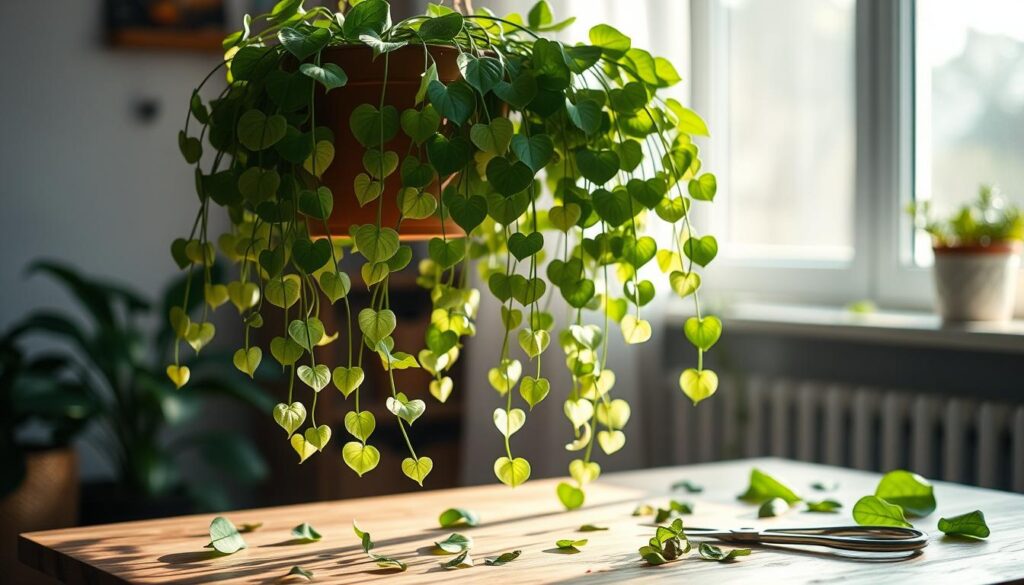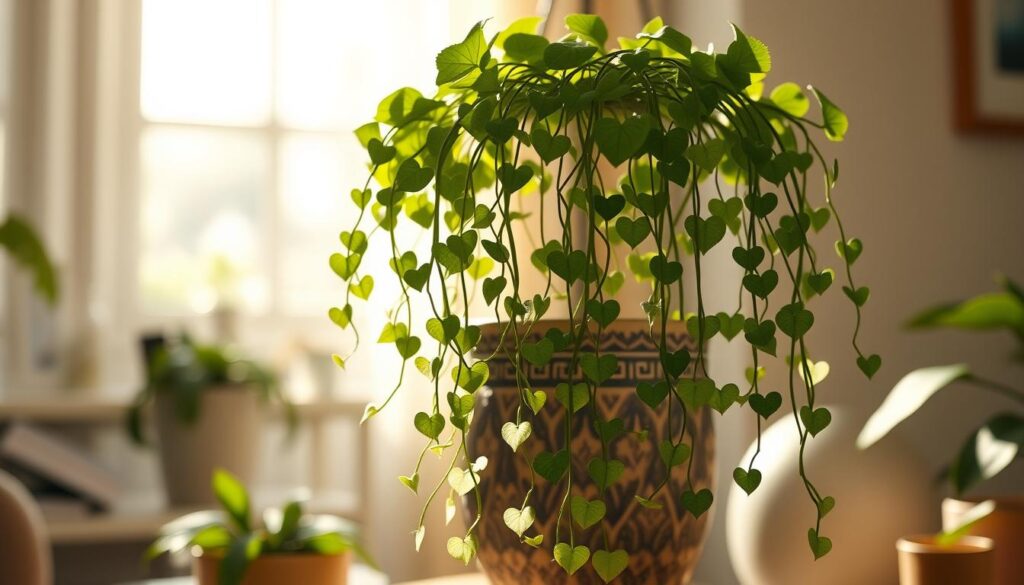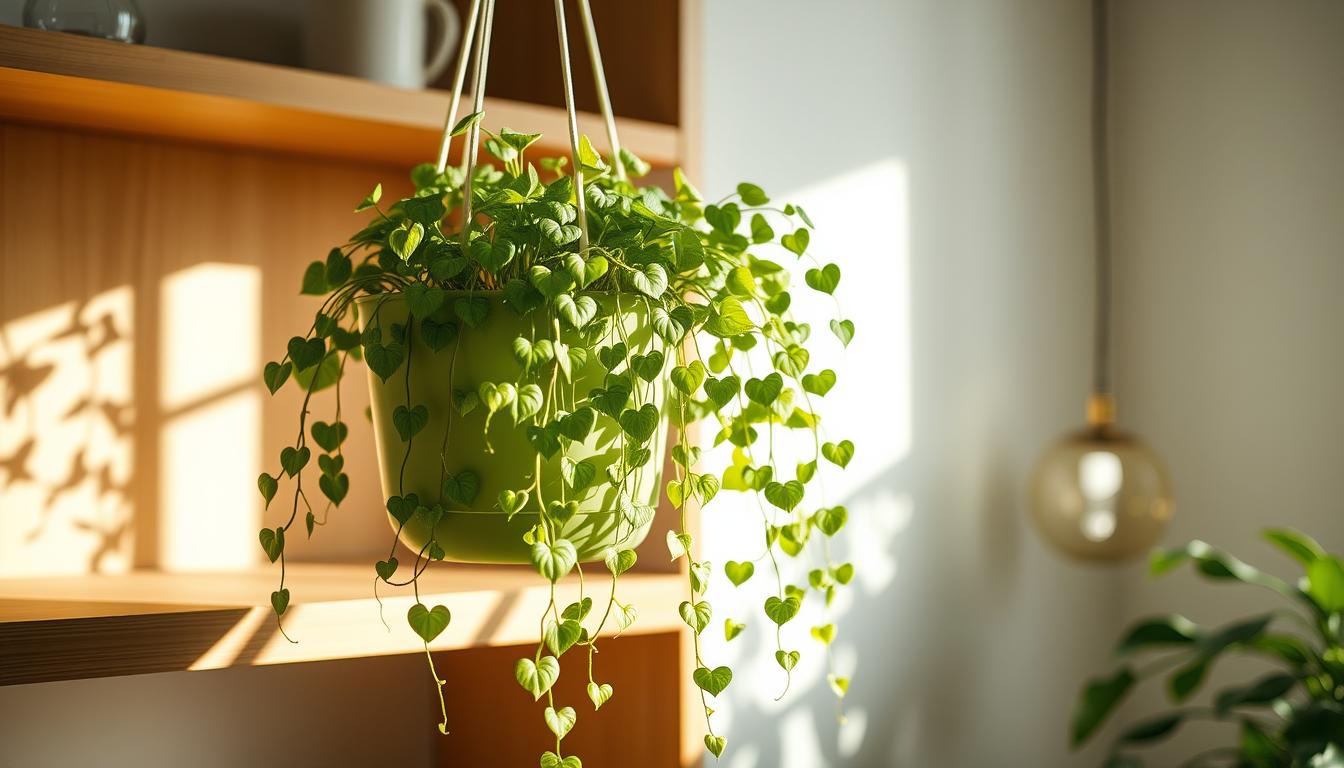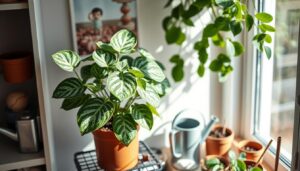Think you don’t have room for houseplants? Think again! Even the tiniest spaces can come to life with the right greenery. The String of Hearts plant, also known as Ceropegia woodii, is perfect for small spaces and needs little care. You can find this beautiful plant for a starting price of £21.00. With proper care, it will thrive in your home.
The String of Hearts is a popular household hanging plant with heart-shaped leaves. It comes from South Africa and Zimbabwe. It is an evergreen and a trailing houseplant, ideal for small spaces. It’s a great choice for your home.
Understanding the basics of String of Hearts plant care is key. With its delicate, trailing vines and heart-shaped leaves, it adds a touch of nature. With the right Ceropegia woodii care, it will flourish.
Key Takeaways
- The String of Hearts plant is perfect for small spaces and requires minimal String of Hearts care.
- It is native to South Africa and Zimbabwe and is an evergreen, trailing houseplant.
- Proper Ceropegia woodii care includes providing bright, indirect light and watering only when the top 2/3 of the soil is dry.
- The plant is drought-resistant and can tolerate temperatures as low as 20°F for short periods.
- It is essential to use a moisture meter and water when it reads “dry” to ensure the best String of Hearts care.
- The String of Hearts plant requires regular potting soil mixed with pumice or perlite for better drainage and generous drainage holes in its pot.
What is the String of Hearts Plant?
The String of Hearts, also known as Ceropegia woodii, is a delicate, trailing plant. It comes from South Africa and Zimbabwe. It’s perfect for small spaces like shelves or hanging pots and needs little care.
When watering your String of Hearts, let the soil dry out completely. This prevents dehydration.
The String of Hearts needs bright, filtered light. It can handle short times of direct sunlight. For more tips on caring for small plants, check out trusted houseplant guides.
Overview of the String of Hearts
The String of Hearts is a versatile, easy-to-care-for plant. Its heart-shaped leaves and vines are great for indoor gardens.
Common Names and Variations
It’s also called Chain of Hearts, Collar of Hearts, Rosary Vine, Hearts-On-A-String, and Sweetheart Vine. Its vines can grow up to 2-3 meters long.
- Scientific Name: Ceropegia Woodii
- Growth Potential: Vines can reach lengths of 2-3 meters
- Ideal Temperature Range: 18°C – 26°C
Knowing what your String of Hearts needs helps you care for it well. This way, you can enjoy its beauty.
Ideal Growing Conditions
To make your String of Hearts happy, know what it likes. It loves bright, indirect sunlight and warm air. The best temperature is between 64°F to 79°F. It also likes a bit of humidity, but it’s okay with what we have at home.
Choosing the right soil is key. Use a mix that drains well, like organic or succulent potting mix. This keeps the roots healthy and prevents water damage. Make sure the soil is dry before watering again.
Want to know how to propagate String of Hearts? It’s simple. Just cut a 4-inch piece of stem. This way, you can share your plant with others.
- Bright, indirect sunlight
- Warm temperatures between 64°F to 79°F
- Average to high humidity
- Well-draining organic potting mix or succulent potting mix
Follow these tips to make your String of Hearts happy. Learn what your plant needs for the best care.
Soil Recommendations
Choosing the right soil for your String of Hearts is key. You need good drainage to avoid root rot. Mix cactus/succulent soil with perlite or pumice for the best results.
This mix drains well but keeps some moisture. It helps your plant grow strong. Watch out for String of Hearts pests that might come from bad soil.
A potting mix that drains well is very important. It stops waterlogged soil that can harm your plant. Use a mix of succulent and cactus soil, coco coir, orchid bark, and charcoal.
This mix drains well but holds some moisture. Regular String of Hearts pruning helps keep pests away.
- Look for a mix specifically designed for cacti and succulents
- Avoid using regular potting soil, as it can retain too much water
- Consider adding perlite or pumice to improve drainage
Choosing the right soil and caring for your plant well can help it thrive. It also lowers the chance of pests and diseases.
| Soil Component | Recommended Ratio |
|---|---|
| Succulent and Cactus Mix | 1/3 |
| Coco Coir | 1/3 |
| Orchid Bark and Charcoal | 1/3 |
Watering Your String of Hearts
Learning to water your String of Hearts is key to its health. This plant, also known as Ceropegia woodii, needs careful watering. Water it when the top 2/3 of the soil feels dry. Make sure to water well and let the pot drain to avoid soggy soil.
Knowing when your plant is thirsty or too wet is important. If it’s too dry, leaves will wrinkle. Too much water can cause leaves to fall off, turn yellow, and become soft. Check the soil often and water as needed.
Signs of Underwatering
- Wrinkled foliage
- Slow growth
- Wilting stems
Signs of Overwatering
- Leaf drop
- Yellowing foliage
- Mushy leaves
By following these tips, your String of Hearts will stay healthy. Water it with care and adjust your schedule as needed.
| Watering Frequency | Soil Moisture |
|---|---|
| Allow soil to dry out completely between waterings | Check soil moisture by sticking your finger into the soil up to the first knuckle |
| Water thoroughly, making sure the pot drains well | Avoid getting water on the leaves to prevent fungal diseases |
Fertilizing Tips
Knowing what your String of Hearts needs is key for it to grow well. Use a balanced, water-soluble fertilizer with equal NPK. Apply it once a year when it’s growing most. This gives your plant the nutrients it needs.
For repotting, pick a potting mix that drains well. You can add pumice or perlite to it.
Don’t over-fertilize your plant. It can hurt it. So, cut the fertilizer in half before using it. Fertilize every 4 to 6 weeks when it’s growing, from spring to early fall. This keeps your plant healthy.
Your String of Hearts needs 4 to 6 hours of bright, indirect light each day. The right light and fertilization will make your plant look great.
Best Types of Fertilizer to Use
- Balanced, water-soluble fertilizer with an equal NPK ratio
- Organic-rich soil featuring perlite, peat moss, and sand for optimal drainage
How Often to Fertilize
Fertilize your String of Hearts every 4 to 6 weeks during the growing season. This is from spring to early fall. It keeps your plant healthy without too much fertilizer.
| Fertilizer Type | Application Frequency |
|---|---|
| Water-soluble fertilizer | Every 4 to 6 weeks during the growing season |
| Slow-release fertilizer | Every 6 months |
Pruning and Propagation
Learning how to prune and propagate your String of Hearts is key. Pruning keeps your plant looking good and growing. To prune, just cut back the long vines. This helps your plant grow fuller.
Propagation is easy with stem cuttings. You can do this during the growing season. Here’s how to propagate your String of Hearts:
- Take a stem cutting with at least three to four nodes
- Remove lower leaves, leaving only two or three at the top
- Place the cutting in water, making sure at least two nodes are submerged
- Keep the cutting in a warm location with bright light

With the right care, your String of Hearts will do great. You’ll love watching it grow. Learning to propagate and prune will let you share your plant. Or, you can just enjoy watching it thrive.
Common Pests and Problems
When you care for your String of Hearts, watch out for pests and problems. Checking your plant weekly can stop pests by more than 70%. Look for String of Hearts pests like mealybugs, spider mites, and scale. These pests can harm your plant if not treated.
Spider mites can damage leaves, causing stippling in up to 80% of plants. Scale insects make plants more likely to get sick. To avoid these, keep humidity between 40% to 60% and quarantine new plants for 2 weeks.
Here are some tips for stopping String of Hearts pests:
- Choose pest-resistant plants to cut down pest problems by 50%.
- Clean your growing area to cut pest numbers by 60% or more.
- Use Integrated Pest Management (IPM) to control pests better by 25-50%.
By following these tips, your String of Hearts will get the best care. It will thrive in its home.
| Pest | Damage | Treatment |
|---|---|---|
| Mealybugs | Up to 30% damage to plant foliage | Insecticidal soap and neem oil |
| Spider mites | Stippling in up to 80% of affected plants | Increase humidity and use insecticidal soap |
| Scale | Reduce plant vigor by as much as 60% | Neem oil and insecticidal soap |
Ideal Container Selection
Choosing the right container for your String of Hearts plant is key. It needs well-draining soil. So, a pot with holes is a must. Also, a slightly acidic to neutral soil mix helps avoid waterlogged roots.
For repotting, pick a pot 1-2 inches bigger than the plant’s roots. This size allows for growth without too much water or dryness. A small pot can slow growth, while a big one might cause moisture and nutrient problems.
Using hanging baskets has perks. They show off the plant’s vines and keep pests away. Here’s how to pick the best container:
- Choose a pot with good drainage holes
- Select a String of Hearts soil mix that is slightly acidic to neutral
- Consider using a hanging basket to showcase the plant’s trailing vines
Follow these tips to make your String of Hearts plant happy in its new home. Keep an eye on the soil moisture. Adjust your watering to avoid root rot. With the right care, your plant will thrive for years.
| Container Size | Root Ball Size | Drainage Holes |
|---|---|---|
| 1-2 inches larger | Same size as the plant’s root ball | Yes, essential for preventing waterlogged roots |
Seasonal Care Tips
As you care for your String of Hearts, change your ways with the seasons. Adjust your String of Hearts watering and String of Hearts sunlight requirements. This helps your plant grow well all year.
In spring and summer, water and feed your plant more often. Use organic fertilizer once a month for growth. Also, give it bright, indirect sunlight for 3-4 hours daily.
Spring and Summer Care
Here are some tips for spring and summer:
- Water when the soil is dry to the touch
- Keep humidity at 40-60%
- Prune to keep your plant the right size
Fall and Winter Care
In fall and winter, water and feed less. Your plant is dormant and too much water can harm it. Here’s how to care for it then:
| Season | Watering Frequency | Fertilization Frequency |
|---|---|---|
| Spring/Summer | Every 7-10 days | Once a month |
| Fall/Winter | Every 4-6 weeks | None |

Frequently Asked Questions
Are you new to String of Hearts care? You might wonder how to keep your Ceropegia woodii happy. We’ve got answers for common questions. This includes how to deal with pests and encourage blooming.
One big question is why leaves turn yellow. It often happens when you water too much. To fix this, water only when the soil is almost dry. Also, water less in winter.
Common Questions About String of Hearts Care
People also ask about pests and how to make their plant bloom. To fight pests, check your plant often and act fast. For blooming, give it lots of indirect light and fertilize once a year.
Troubleshooting Common Issues
Having trouble with your String of Hearts? We’ve got tips to help:
- Yellowing leaves: Check your watering schedule and adjust as needed.
- Pests: Inspect your plant regularly and treat any infestations promptly.
- Lack of blooming: Provide your Ceropegia woodii with bright, indirect light and fertilize it once a year.
Follow these tips to become a pro at String of Hearts care. Always think about what your plant needs. And don’t be afraid to ask more questions about Ceropegia woodii care.
| Common Issue | Solution |
|---|---|
| Yellowing leaves | Adjust watering schedule |
| Pests | Inspect and treat promptly |
| Lack of blooming | Provide bright, indirect light and fertilize |
Creative Display Ideas
There are many ways to show off your String of Hearts plant. You can use hanging strings or baskets to make it look elegant. Remember to prune your plant often. This keeps it looking good and gives you pieces to grow more plants.
Here are some cool ways to display your String of Hearts:
- Try a macrame hanger for a boho look.
- Make a living wall with a trellis.
- Put it with other plants or flowers for a special mix.
Before you start, make sure to repot your String of Hearts. This keeps the roots healthy and stops rot.
Being creative with your String of Hearts display makes your space unique. It lets you enjoy this special plant’s beauty.
| Display Idea | Description |
|---|---|
| Hanging Basket | A classic way to showcase your String of Hearts plant, perfect for adding a touch of greenery to any room. |
| Trellis | A great way to train your plant to climb and add a decorative element to your space. |
| Topiary | A unique and elegant way to display your String of Hearts plant, perfect for adding a touch of sophistication to any room. |
Conclusion: Enjoying your String of Hearts
The String of Hearts (Ceropegia woodii) is a beautiful and easy plant for your home. It has heart-shaped leaves and doesn’t need much care. This plant can live for years, adding beauty to your space.
Make sure your String of Hearts has the right temperature, lighting, and watering. This keeps it healthy and looking good. Also, pruning and propagation help it stay full and pretty. Follow this guide to enjoy your String of Hearts and its many benefits.
Display your String of Hearts in a hanging basket or on a shelf. Its leaves will make any room look better. Take care of your Ceropegia woodii and enjoy cleaner air, less stress, and a closer feel to nature.
To Check out other great options for your indoor gardening in compact spaces see our article on 10 houseplants for small spaces HERE!
If you enjoy developing your indoor garden you can see 100 Houseplant choices in our post of 100 trending hosueplants guide!





Pingback: The Ultimate Guide to Houseplants: 100 Best Indoor Plants for Every Home - Trusted House Plant Guide